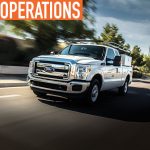Truck salespeople, fleet managers, and end users face challenges in determining the right work truck for a specific application. When replacing a commercial vehicle with something similar, the first inclination is often to copy the existing work truck specifications into the replacement vehicle. However, with the variety of advancements in vehicle technologies and chassis changes year-to-year, a more systematic approach is warranted. Assessing user needs and expectations is key to the successful selection of any work truck. User needs can include identification of:
Desired truck body and equipment, such as liftgates, cranes, or other work equipment
Expected payload needs, which help shape the work truck’s size, weight class, and GVWR needed to properly perform a function
GVWR may be specified to avoid a commercial driver’s license (CDL) for electrical technicians who use the vehicle to perform duties, but are not truck drivers, or to circumvent service hour restrictions for repair technicians. Note, chassis GVWR limitations to avoid CDL requirements will directly affect equipment and payload the specific chassis can haul.
GETTING STARTED
One of the first steps in creating a robust truck specification is performing a payload analysis. This involves reviewing the proposed chassis, body, equipment, and accessory weights, and comparing them to the proposed vehicle’s GVWR. The remaining leftover weight is the available payload.
If payload is sufficient for your work truck needs, the next step is to perform a full weight distribution analysis, which will allow you to determine if the truck chassis, body, and equipment combination will work with the desired chassis.
Another parameter to consider when creating a vehicle specification is gross axle weight rating (GAWR). This is the maximum weight an individual axle can carry when measured at the tire-to-ground interface. GAWR is a critical element in the weight distribution calculation, because it will either confirm the truck can be built as specified or signal that adjustments must be made to equipment placement or payload in order to properly meet GAWR capability.
A complete weight distribution analysis will determine if the weights on each individual axle are within GAWR limitations. Exceeding GVWR and/or GAWR will reduce the truck’s durability, increase maintenance costs, and potentially create a safety concern. Additionally, an overloaded truck could present a liability risk for the owner and seller. Proper chassis specifications can help reduce this possibility.
FEDERAL BRIDGE FORMULA
Once you determine the vehicle can be built using the desired chassis, body, and equipment, assess its ability to carry payload. This is done by checking axle loads against state and federal maximum weight laws. In the US, the interstate highway system and federally designated roads in each state use the federal bridge formula to determine maximum allowable truck weight on their respective roads. Many states have different weight restrictions for roads under their control (non-interstate and federally designated roads); however, there are some exceptions.
Restrictions typically apply to individual axle weights, axle grouping weights, and total vehicle weights. For example, under the federal bridge formula, the amount of weight a single drive axle can carry is limited to a maximum of 20,000 lbs (34,000 lbs for a tandem axle system). The full weight the truck is allowed to carry is based on total number of axles and distance from the center of the forward-most axle to the rearward-most axle.
To illustrate, consider a three-axle truck consisting of a steering axle and tandem rear axle, with a 214-inch wheelbase, 58,000-lb GVWR, front axle at 18,000 lbs GAWR, and rear tandem axle at 40,000 lbs GAWR. Take into account the wheelbase dimension is measured from the front axle to the center of the tandem. The additional distance from the center of the tandem axle to the center of the rearmost axle needs to be added to the wheelbase to determine distance from steering axle to rearmost axle. In this example, that distance is 240 inches (or 20 ft). This dimension will be important in establishing the truck’s total carrying capacity under the federal bridge formula.
According to the federal bridge formula table, a truck with three axles and a distance of 20 ft between the extremes of a group of two or more consecutive axles, maximum total allowable weight is 51,000 lbs. A comparison of vehicle axle ratings and weight law limitations shows the rear tandem axle has a greater capacity at 40,000 lbs than the weight law of 34,000 lbs—thus, requiring payload capacity stay within the 34,000-lb tandem federal weight law limitation (your state may have a higher road limit). The weight distribution performed earlier can help you verify the new payload or if the front axle rating will permit equipment repositioning to allow for additional payload. This weight law limitation is common in heavy-duty truck chassis normally greater than 33,000 lbs GVWR.
PLAY IT SAFE
For most light- and medium-duty vehicles, normally ranging from 6,000 to 32,000 lbs GVWR, federal and state weight law limitations will not affect maximum vehicle weight, and your truck’s individual axle weight ratings will be key factors in defining maximum payload.
When determining chassis specifications for a work truck, it’s important to fully understand the end user’s body, equipment, and payload needs to properly size the chassis for safety, durability, and customer satisfaction. Combined with an understanding of weight distribution and weight law analysis, you can successfully deliver a safe and proper truck.
ABOUT THE AUTHOR:
Bob Raybuck is the director of technical services at NTEA. Established in 1964, NTEA represents 1,900 companies that manufacture, distribute, install, sell, and repair commercial trucks, truck bodies, truck equipment, trailers, and accessories. NTEA provides in-depth technical information, education, and member programs and services, and produces The Work Truck Show®. Find out more, visit www.ntea.com.
_______________________________________________________________________
MODERN WORKTRUCK SOLUTIONS: JUNE 2017 ISSUE
Did you enjoy this article?
Subscribe to the FREE Digital Edition of Modern WorkTruck Solutions magazine.
![]()




